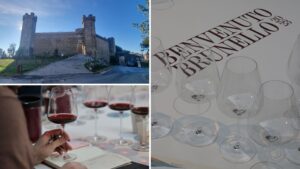Tucked into the western benchlands of Oakville, Opus One stands as a beacon of sophistication and legacy in Napa Valley winemaking. During a recent visit, I was invited to experience a rare vertical tasting that spanned some of the estate’s most celebrated vintages. This exclusive encounter offered more than a glimpse into the artistry behind each bottle, it was a masterclass in precision, pedigree, and the enduring partnership between two visionaries: Baron Philippe de Rothschild and Robert Mondavi.
During my recent visit, I experienced an unforgettable vertical tasting in the Partners’ Room, hosted by the knowledgeable and gracious Therese Keating, Estate Ambassador. Ms Keating previously provided us with an in-depth insight into the Opus One’s history, viticulture and winemaking philosophy. Against a backdrop of breathtaking vineyard views, we explored three vintages: 2015, 2019, and 2021, each paired with meticulously crafted amuse-bouches.
2015 Opus One
Blend: Cabernet Sauvignon 81%, Cabernet Franc 7%, Merlot 6%, Petit Verdot 4%, Malbec 2%
Skin Contact: 21 days
Barrel Aging: 18 months in new French oak
Tasting Notes: A warm vintage showing opulence and depth. Aromas of dark plum, violet, and tea leaf give way to a lush palate of blackberry, cocoa, and baking spices, creamy texture, fine tannins, and great balance.
Drink Window: 2025–2040
96 points – Liz Palmer
2019 Opus One
Blend: Cabernet Sauvignon 78%, Merlot 8%, Petit Verdot 6%, Malbec 2%
Skin Contact: 22 days
Barrel Aging: 19 months in new French oak
Tasting Notes: A composed and classic vintage. Notes of black currant, rose petal, and graphite lead into layers of espresso, dark chocolate, and savoury herbs. Silky texture, bright acidity, and a lingering finish.
Drink Window: 2025–2045
98 points – Liz Palmer
2021 Opus One
Blend: Cabernet Sauvignon 93%, Cabernet Franc 4%, Petit Verdot 2%, Merlot 0.5%, Malbec 0.5%
Skin Contact: 19 days
Barrel Aging: 19.5 months in new French oak
Tasting Notes: From one of the driest growing seasons on record, this vintage is defined by purity and finesse. Aromas of cassis, violet, and black cherry evolve into a palate of elegant tannins and a finish marked by truffle, vanilla, and spice.
Drink Window: 2029–2049
99 points – Liz Palmer
Each wine was paired with exquisite culinary expressions, from bacon and Roquefort canelés to truffle-scented morel gâteau, amplifying the sensory journey. This rare opportunity to observe how the estate’s wines evolve in character and structure over time was both intellectually stimulating and emotionally resonant.
Final Reflections
Opus One is more than a wine estate; it is a living philosophy, where tradition and innovation are intertwined with purpose and grace. Every detail, from grape to glass, reflects a pursuit of perfection rooted in legacy and collaboration. For connoisseurs and collectors, a visit to Opus One is nothing short of a pilgrimage, an invitation to experience the art of fine winemaking at its most refined.
“The most unique wine tasting experience in Napa is at Opus One. Uncover the art of Bordeaux blends, breathtaking architecture, and a wine experience like no other.” — Liz Palmer
Opus One Winery
📍 7900 St. Helena Highway, Oakville, CA
🌐 https://en.opusonewinery.comm






